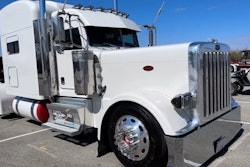Both houses of Congress included measures in transportation appropriations bills that would severely restrict – if not prohibit outright – Mexican truckers from crossing the border in NAFTA trade.
President Bush vowed to open the border to cross-truck traffic by January. But the House of Representatives voted in June to prohibit the Department of Transportation from implementing any phases of its program to open the border next year. In August, the Senate passed a $60.1 billion transportation funding bill that includes stringent safety requirements for Mexican truckers before they are allowed entry.
The moves likely mean the final appropriations bill that ends up on the president’s desk will include more stringent restrictions on Mexican trucks operating in the United States than the administration has proposed. The Federal Motor Carrier Safety Administration recently introduced rules that include auditing Mexican companies within 18 months of receiving provisional authority to operate in the U.S. Rules requiring periodic inspections of vehicles as they cross the border would also be developed.
Speaking at a trucker “town hall” meeting in Las Vegas in June, FMCSA chief safety officer Julie A. Cirillo said the agency had introduced rules designed to ensure that Mexican carriers abide by the same rules and standards as U.S. and Canadian carriers. “We are asking the Mexican carriers to do the same things U.S. and Canadian carriers do,” she said.

Cirillo also said her agency had asked for authority to increase federal inspectors at the border from 238 to 496 over the next year, but funding for that staff increase was uncertain.
That wasn’t enough for Sens. Patty Murray, D-Wash., and Richard Shelby, R-Ala. The senators were key authors of 22 safety provisions that would have to be met before Mexican trucks would be permitted to travel the U.S. The standards include regular U.S. inspections of Mexican trucks and drivers, onsite audits of Mexican trucking companies, and more inspectors and scales at the 27 U.S. border stations.
Administration officials have previously said the president would veto a transportation bill that prevented him from opening the border by January, but some Senate watchers predict opponents may have the votes needed to override a veto.
The Senate vote was praised by both the Teamsters union and the Owner-Operator Independent Drivers Association.
“We are grateful that a majority of senators understand that the safety of our highways is more important to the American public than whatever trade benefits our country may gain from a premature opening of the border to Mexican trucks,” OOIDA president Jim Johnston said in a press release following the Senate vote.
While both organizations claimed safety was the main reason behind their support of the Senate’s vote – some statistics show a Mexican truck is 50 percent more likely to fail a safety inspection than an American truck – economic issues played a role as well.
The Teamsters union has lobbied against NAFTA and its trucking provisions for several years, saying the measures threaten union jobs. Likewise, Todd Spencer, OOIDA executive vice president, told Truckers News earlier this year that while safety was his group’s key concern, it was also worried about cabotage – point-to-point freight movement within the U.S. by foreign carriers.
“Once Mexican trucks start entering the U.S., there will be little incentive to go back south,” Spencer said. “They will simply stay in the U.S. to the economic detriment of U.S. truckers.”
Some argue the predicted flood of Mexican truckers seeking U.S. operating authority will actually be more like a trickle.
Cirillo told a House Appropriations subcommittee her agency expected about 3,500 Mexican carriers to apply for U.S. authority. Most of those applications will come from the roughly 9,000 Mexican carriers now operating within 20-mile border zones.
The measure now goes to a House-Senate conference committee where the differences between the two bills are ironed out before going to the president for his signature. The appropriations are for the fiscal year beginning Oct. 1.










